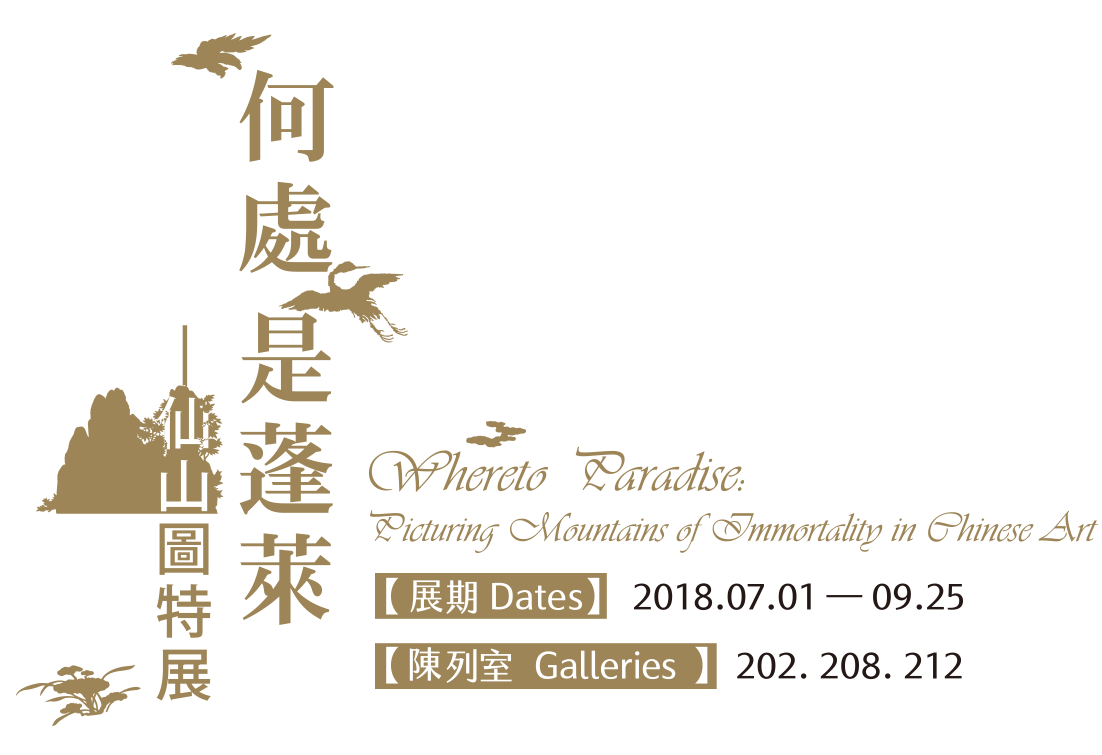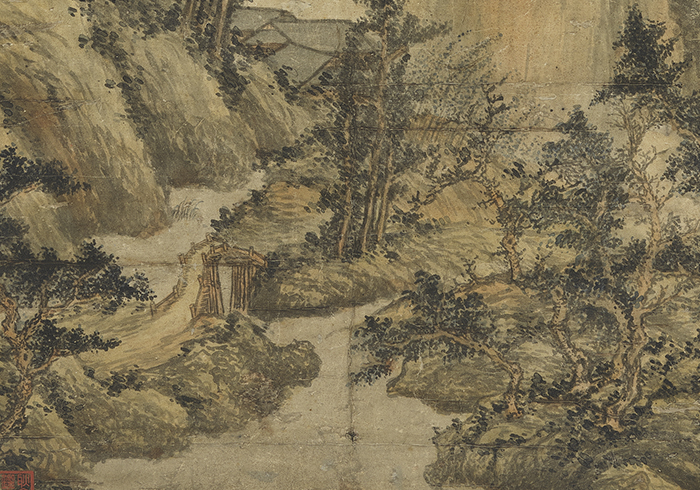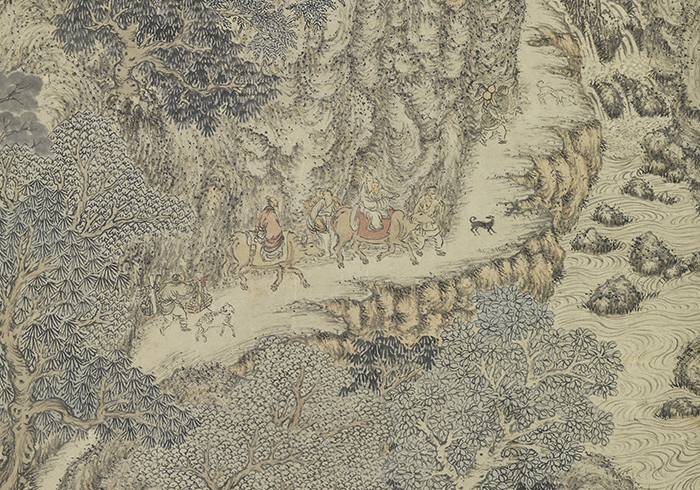Compared with the mountains of immortals that lie beyond the seas, famous mountains and so-called "grotto heavens and blessed lands" offered Daoists and other mortals an even more approachable realm of the sacred. "Grotto heavens were thought to be luminous sites with natural lighting that served as the residence of spirits and deities, even being channels of communication. The fictional chance discovery of the Peach Blossom Land, for example, tells how a mortal went through a grotto to reach a utopian realm of immortality.
Grotto Heavens and Mountain Halls
- Attributed to Dong Yuan (fl. first half of the 10th c.), Five dynasties period
- Hanging scroll, ink and colors on silk, 183.2 x 121.2 cm
- The display period of this "restricted" work is from July 1 to August 13.
This work bears neither seal nor signature of the artist, but Wang Duo (1592-1653) in the inscription paper mounted above gives the artist as Dong Yuan of the Five Dynasties period. Dong, a native of Zhongling in Jiangnan (modern Nanchang in Jiangxi), excelled at "hemp-fiber" texture strokes to depict the Jiangnan landscape, establishing an important tradition in Chinese painting. Although this work reflects his style, it was actually done in the Yuan dynasty (1279-1368).
In the lower right are three figures on a bridge, two of them wearing official caps and having gone to greet a visitor. In the middleground is a lofty palatial complex hidden among the trees in the clouds, which make the blue-and-green peaks stand out clearly with grotto entrances of different sizes evident. The natural lighting of the grotto entrance accords with the Daoist notion of mountains and grottoes being immortal palaces and spiritual abodes, which religious thought says are lit by the sun and moon. Four characters for the title are in the upper left, and, although the writer is unknown, they suit well the subject of the painting.
Sacred Mountains and Precious Groves
- Fang Congyi (1301-after 1378), Yuan dynasty
- Hanging scroll, ink and colors on paper, 120.3 x 55.7 cm
- The display period of this "restricted" work is from August 14 to September 25.
Fang Congyi (sobriquet Fanghu [the name also of a mountain of the immortals]) was a Daoist of the Zhengyi Sect at the Shangqing Temple on Dragon Tiger (Longhu) Mountain in Jiangxi. He was studied in the arts of immortality under the leader of the Quanzhen School, Jin Pengtou (1276-1336).
The artist himself gave the title of this painting. In it, "precious groves" refers to the Precious Groves (Qionglin) Terrace at Dragon Tiger Mountain. The term for "sacred mountains" comes from Declarations of the Perfected by Tao Hongjing (456-536) of the Liang dynasty in the Southern Dynasties period. As such, it clearly shows the painter consciously manifesting the religious notion of sacred mountains in Daoism. In the foreground are lush trees as a broad expanse of water narrows into the recesses. Hidden in the middle are buildings in bamboo groves as a recluse holds a staff to ascend a terrace at the left. Compared to the towering peaks on the other side, he appears miniscule. The landscape forms were done with moist swaths of the brush with dots and washes, the brushwork straightforward and intuitively expressing the extraordinary aura of sacred mountains.
Imitating Wang Meng's "Ge Hong Moving"
- Zheng Zhong (fl. early 17th c.), Ming dynasty
- Hanging scroll, ink and colors on paper, 135.8 x 29.1 cm
"Immortal Elder Ge," the subject of this work, refers to Ge Hong (283-343), a native of Jurong in Danyang during the Jin dynasty and a representative of the Jindan (Golden Elixir) Sect in Daoism. Ge believed that only by refining elixir and practicing in the mountains could one achieve the Dao. In his old age, he heard that the materials for producing the elixir of immortality had been discovered in the area of what is now Vietnam. Taking his sons and nephews with him, he set off but on the way was detained by the Governor of Guangzhou, Deng Yue. Ge thereupon settled down in nearby Luofu Mountain to concoct the elixir and practice the Dao, reportedly becoming an immortal upon his death.
Zheng Zhong did this painting with dense brushwork, the composition being quite narrow. In the foreground can be seen Ge Hong and his wife, Bao Gu, riding oxen with attendants carrying geese and other things accompanied by a goat and dog. The tortuous path winds up the mountains to an idyllic scene with a Daoist temple, portraying the pursuit and visualization of the path to immortality.



